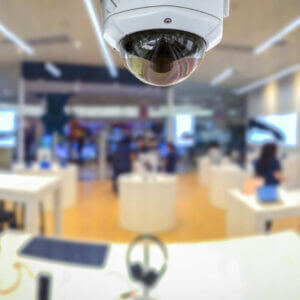7 Layers of Cyber Security
It is a common misconception that cyber security is as simple as downloading security software. The truth is that there are many cyber security layers that need considerate thought and implementation to protect your IT infrastructure.
The 7 layers of cyber security are:
- Physical security
- Network security
- Perimeter security
- Endpoint security
- Application Security
- Data security
- User education
Physical Security
 Physical security is restricted access to spaces where your hardware and data are stored. This includes investing in security measures to prevent the theft of your physical assets.
Physical security is restricted access to spaces where your hardware and data are stored. This includes investing in security measures to prevent the theft of your physical assets.
Physical security measures include security cameras, RFID key card door locks, burglar alarms and onsite security guards.
Physical security prevents direct access to your computer systems and therefore minimises your risk of theft or damage.
Network Security
 Network security includes both hardware and software protection but it is mainly implemented to protect your network infrastructure and data flow.
Network security includes both hardware and software protection but it is mainly implemented to protect your network infrastructure and data flow.
Your network is the connection of all your devices and how they share data with each other.
Network security measures include setting and enforcing security policies and procedures and installing hardware and software that can automatically detect and block network security threats.
Types of network security measures include firewall protection, intrusion detection software, cloud security and VPNs.
Perimeter Security
 Perimeter security is controlling access to your network through routers and gateways. The primary aim is to prevent unauthorised access by securing the boundaries of your network.
Perimeter security is controlling access to your network through routers and gateways. The primary aim is to prevent unauthorised access by securing the boundaries of your network.
You can control access to your network with strong firewall settings, enforcing VPN for remote access, data encryption, network monitoring, secured devices and vulnerability management.
Endpoint Security
 Endpoint security means that all devices connected to your network are secured. Common endpoint devices include tablets, laptops, smartphones, printers, atm machines and smartwatches.
Endpoint security means that all devices connected to your network are secured. Common endpoint devices include tablets, laptops, smartphones, printers, atm machines and smartwatches.
If a device is connected to your network, it is considered an endpoint.
This is because all devices have the potential to be hacked and cause a threat to your network. Endpoint security software can protect and monitor a wide variety of endpoints.
Application Security
 Application security is the process of designing and configuring your software application code and data against cybersecurity threats.
Application security is the process of designing and configuring your software application code and data against cybersecurity threats.
Application security is specific to finding, fixing and preventing security vulnerabilities within applications.
Application security features include authentication, authorisation, encryption, logging and application security testing.
Data Security

Data security is the creation of backups or the duplication of data to protect against accidental data loss or erasure.
Data encryption is used to prevent cyber criminals from accessing your data if they manage to breach your network security.
Data policies and strategies need to be put in place to respond to the potential wiping out or theft of data.
User Education
 User education ensures that users are educated on the best practices for cyber security.
User education ensures that users are educated on the best practices for cyber security.
Such as using secure passwords, setting two-factor authentication methods and reporting malicious or suspicious activity.
An organisation’s human layer is its people, and they need to be made aware of the tactics used by cyber attackers in order to protect their business’s mission-critical assets.
Our cyber security consultants can help detect the weakest link in your layers of cybersecurity measures. We can help determine whether your business is at risk of a data breach and can ensure that you have an adequate amount of all 7 layers of security. Contact our Hull-based IT Support team today,



